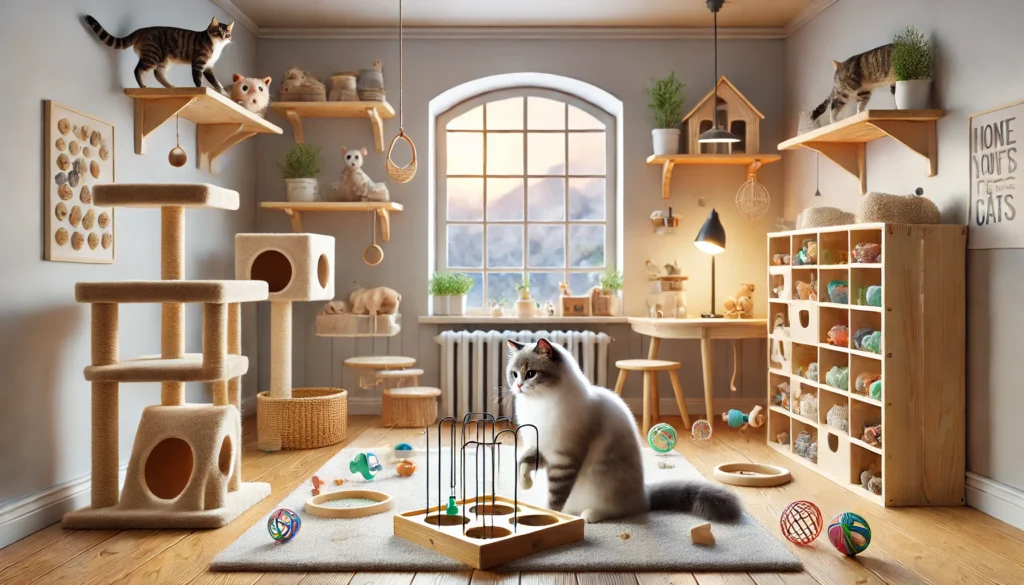Indoor cats live longer, safer lives — but they also face a hidden risk: boredom. Without enough mental stimulation and outlets for their natural instincts, even the most affectionate feline can develop behavioral problems like destructive scratching, overgrooming, or meowing excessively. Fortunately, it doesn’t take expensive toys or a big apartment to keep your indoor cat mentally and emotionally satisfied.
This guide will show you how to recognize boredom in cats, and how to prevent it with simple, sustainable routines and home enrichment strategies.
Why Indoor Cats Get Bored
Unlike outdoor cats who can roam, hunt, and explore freely, indoor cats live in the same space every day. Without novelty, variety, and challenge, they may:
- Sleep excessively out of disinterest
- Become destructive (scratching furniture, chewing plants)
- Seek constant attention
- Chase or pounce on other pets
- Show signs of anxiety or depression
Cats are curious, intelligent animals — they need stimulation to thrive.
Signs Your Cat Is Bored
Some cats are subtle about their frustration. Look for these behaviors:
- Excessive vocalizing, especially around feeding times
- Sleeping in unusual or hidden places all day
- Pawing at doors or windows
- Overeating or refusing food
- Zoomies or random bursts of energy at night
- Grooming obsessively, sometimes to the point of fur loss
These aren’t just quirks — they’re signals that your cat needs more engagement.
Daily Enrichment Habits That Prevent Boredom
1. Rotate Toys Regularly
Cats quickly lose interest in toys that are always available. Keep a box of 8–10 toys and only leave out 2–3 at a time. Rotate every few days.
Include:
- Soft mice
- Feather toys
- Crinkle balls
- Catnip-infused plush
- Motion toys
Each rotation feels like a new surprise.
2. Schedule Short Play Sessions
Play is hunting practice for cats. Use 10–15 minutes per session, 2–3 times daily.
Use wand toys, laser pointers (end with a toy they can “catch”), or small tossable toys. End sessions with a treat or cuddle to simulate a successful hunt.
3. Add Vertical Territory
Cats need height to feel secure and stimulated.
Add:
- Wall shelves
- Cat trees
- Bookcases with access steps
- Window perches or ledges
Being able to survey their environment gives cats purpose and control.
4. Introduce Puzzle Feeders
Instead of food bowls, use:
- Ball feeders
- Snuffle mats
- Cup or egg carton DIY puzzles
- Lick mats for calm stimulation
These slow down eating and mentally engage your cat in a fun, rewarding way.
5. Offer Window Entertainment
Place a perch near a sunny window where your cat can watch the world go by. Add a bird feeder outside for visual stimulation, or leave the window cracked (with a secure screen) for fresh air.
Window time = natural enrichment.
6. Use Safe Scents and Sounds
Engage your cat’s other senses:
- Play soft nature sounds or cat-specific music
- Rotate blankets or bedding with new textures
- Sprinkle a little catnip or silvervine on toys
- Add a pet-safe plant like wheatgrass or lemongrass
Scent and sound variety can keep their space fresh and mentally interesting.
Weekly or Seasonal Enrichment Ideas
Even minor changes have a big impact.
- Rearrange their play area once a week
- Introduce cardboard boxes, tunnels, or paper bags
- Set up themed play (autumn leaves, holiday decorations)
- Try a new type of treat or homemade toy
- Occasionally bring out a scent they don’t know (like chamomile or rosemary, used in moderation and safely)
Enrichment isn’t about perfection — it’s about surprise and variety.
Social Enrichment: It’s Not Just Toys
Boredom can also come from a lack of social interaction.
- Talk to your cat throughout the day
- Let them “help” you with chores
- Train simple tricks (sit, high-five, come) with clicker methods
- Schedule cuddle or brushing time after meals
- Let them join video calls or TV time
Cats bond through proximity and routine — even short moments count.
For Multi-Cat Homes
Enrichment can help reduce boredom-based conflict between cats.
- Create separate play areas and perches
- Provide multiple litter boxes, feeding stations, and resting spots
- Use scent swapping to reduce competition
- Play with them together, but also separately
A stimulated cat is less likely to redirect frustration toward another.
Monitor Their Response
Not every cat will enjoy every toy or activity. Pay attention to:
- What types of toys they pounce on
- Preferred times of day for play
- Sensory preferences (sound vs. texture vs. movement)
- Signs of stress or overstimulation (ears back, hiding, biting)
Tailor enrichment to their personality — and don’t force what doesn’t work.
Boredom Isn’t Inevitable Indoors
Cats may not need a backyard, but they do need variety. With just a few minutes a day and some creativity, you can make your home a place of daily adventure — where your cat gets to climb, explore, play, and rest with confidence.
And in return? You get a happier, healthier, more relaxed feline companion.






